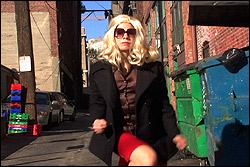Cultural references are thick on the ground in all of 33 Fainting Spells’ shows—the landscape covered in empty Tab cans in 2002’s Dirty Work, the faux weightless sandwich bread in last year’s Our Little Sunshine. Although the Spells’ Dayna Hanson is performing solo in Spirit Under the Influence (8 p.m. Thursday, May 19–Saturday, May 21, at Northwest Film Forum; 206-329-2629), her desire to make many disparate connections, like a performance-art pack rat, is still intact. In just over an hour, Hanson touches on the films of John Cassavetes, the development of biodiesel, paranormal experiences, and celebrity interviews, all interspersed with personal stories about her artistic process and her parenting. She choreographed the dancing, wrote the music, collaborated on the extensive text with Linas Phillips, and, in the course of the show, makes a couple of grilled cheese sandwiches and serves them to people in the front row. Like a skilled juggler with several balls in the air, Hanson manages to keep her ideas in control and our attention focused on the topic at hand.
The multiple ideas that Hanson has woven throughout the work begin with her attempt to make a small contribution to the struggle against global warming by converting her car to run on cooking oil. But this notion is soon joined by discussions about “OBEs” (out-of-body experiences) and the power of love to integrate the disparate parts of our lives. Since she utilizes parts of her own life, as well as the lives of her two sons, she offers a more direct portrait of herself than in previous pieces—this is literally the closest to home that Hanson’s work has ever come.
Her desire to convert her car engine was a response to one son’s concerns about the environment, and Spirit‘sreferences to Hanson’s children are some of the most powerful and tender elements of the work. As much theater as it is dance, the show often makes good use of film and video materials: On film, she drives her boys to school, she cooks them dinner, she does a goofy dance with them to Fleetwood Mac. Despite concerns like divorce and artistic frustration, the thread of their relationship grounds her actions as well as this work itself. And at the end, in a kind of reverse Mother’s Day greeting, she recites a litany of things she loves about her sons and her appreciation for their place in her life.
Over the last several years, there has been a resurgence of multimedia performances, with different approaches to combining live and taped material and with varying degrees of success. In Spirit, Hanson finds the point of equilibrium as she shadows projected images of herself, “interviews” films of her family, or dances to filmed manipulations of time, place, and sequence, acting as a kind of live-action counterpoint for the altered movement on the screens around her. As a dancer, Hanson frequently works best in a limited space, taking the energy that other choreographers use to move their performers across the stage and transferring it to detailed gestural sequences or subtle shifts in posture or facing. In a larger theater, these up-close actions don’t always read very clearly; in the small NWFF venue, Hanson has an environment that matches her personal kinesphere.








